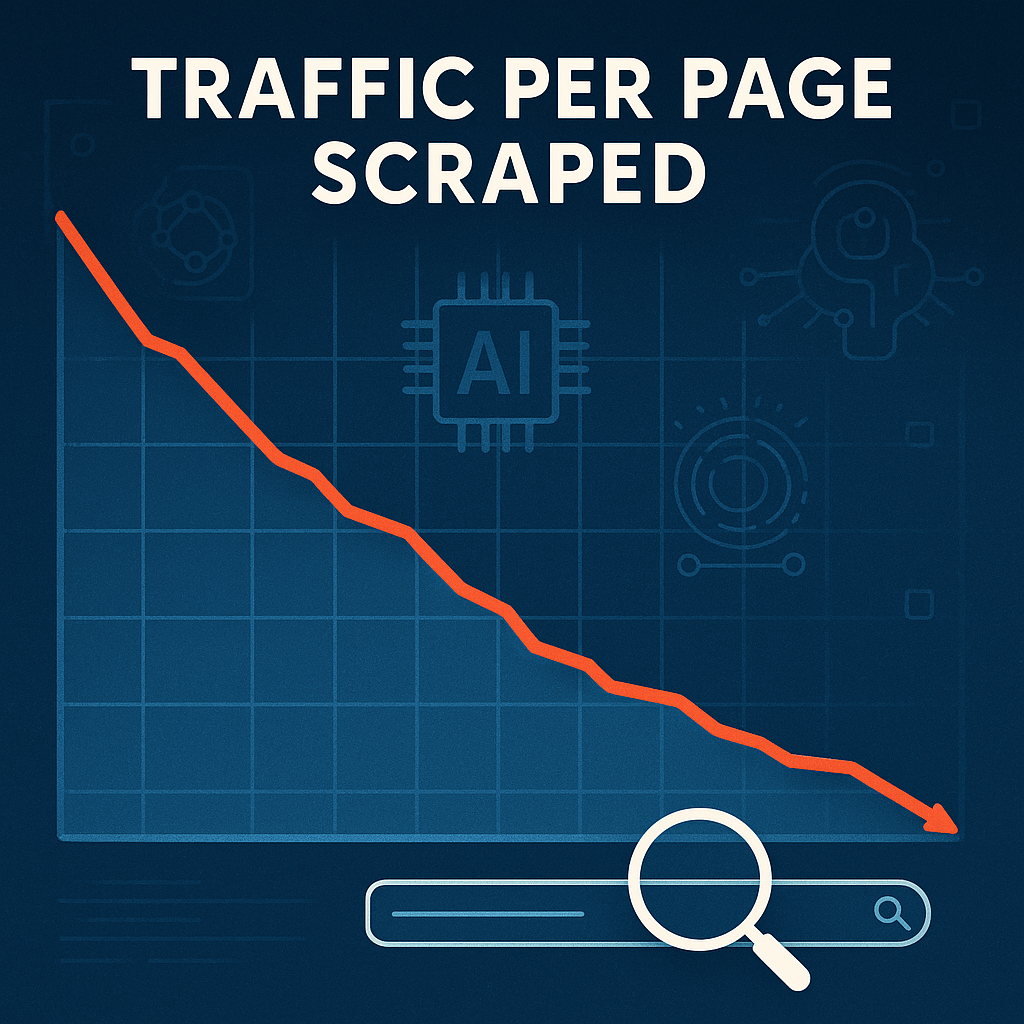The Traffic Collapse Is Real: Why AI Search Is Killing Clicks, and What Marketers Need to Do About It
Two years ago, you could count on Google to send you a steady stream of clicks for every well-optimised blog post. Today? You might be lucky to get a handful—even if Google scrapes your page hundreds of times.
It’s not your SEO strategy that’s broken. It’s the entire discovery pipeline.
Over the past year, both Google and OpenAI have radically shifted how they serve users, prioritising AI-generated answers over external links. The impact on traffic is undeniable. But what’s actually true, what’s overblown, and what does this mean for your marketing strategy in the next 12–18 months?
Let’s unpack the real numbers and explore the fallout.

What the Data Actually Says About Scrape-to-Visit Ratios
This all started with a series of eye-opening comments from Cloudflare CEO Matthew Prince, who dropped some harsh truths about how little traffic platforms now send in return for content scraping.
Google: From Partner to Parasite?
It turns out the idea that Google used to deliver 1 visit per page scraped is a myth—or at least a misunderstanding. Here’s the correct timeline:
| Timeframe | Google Scrape-to-Visit Ratio |
|---|---|
| 10 years ago | 2:1 (1 visit for every 2 pages scraped) |
| 6 months ago | 6:1 |
| Today | 15:1 to 18:1 |
Why the nosedive? Google’s AI Overviews give users direct answers to questions within the search results page. No click required. No referral generated. No credit or compensation to the publisher.
Even if your content powers the answer, you’re invisible.
“We are watching a collapse,” Prince warned in June. “AI tools are draining the open web’s oxygen supply.”
This isn’t about bad SEO. It’s about zero-click search becoming the default.
🤖 OpenAI: A One-Way Street for Content
Google’s bad, but OpenAI is worse.
| Timeframe | OpenAI Scrape-to-Visit Ratio |
|---|---|
| 6 months ago | 250:1 |
| Today | 1,500:1 |
Yes, you read that right. For every 1,500 pages OpenAI scrapes from the web, it sends back just one visit.
This isn’t surprising when you consider how tools like ChatGPT and Perplexity work. The AI surfaces responses in a self-contained chat—often including citations, but buried behind dropdowns or collapsed UI elements that very few people ever click.
And to be blunt, the user doesn’t want to click. They want an answer. Not a link.
The Fallout: Marketing Is Already Changing
These ratios aren’t just stats—they’re signals that the entire content economy is being reshaped. Here’s what that looks like on the ground.
1. Paid Advertising Is Filling the Gap (and Getting More Expensive)
With organic reach drying up, marketers are scrambling to preserve visibility through:
- Google Ads and social spend
- Sponsored placements and influencer deals
- Native ads on content aggregators and AI platforms
The result? Higher competition, especially in B2B and eCommerce, and a rising cost-per-click across most ad platforms. We’re already seeing signs of “auction inflation” as brands shift budget to compensate for the loss of organic traffic.
If you’re not spending, you’re vanishing.
2. Content Is Going AI-First, for Better or Worse
To cope with content velocity demands, marketers are increasingly:
- Using generative AI to write blog posts, newsletters, and landing pages
- Creating multiple content variations for A/B testing at scale
- Publishing more often—but with less differentiation
This leads to a new kind of problem: everyone is saying the same thing, faster than ever before. We’re headed for what some call a “content collapse”, where value drops as volume explodes.
The paradox? Human-made, insightful content has never been more valuable—but only if it can be discovered.
3. The SEO Playbook Is Being Rewritten
Old SEO rules—keyword targeting, long-form guides, backlink building—are becoming less effective in an AI-dominated search landscape.
Now, it’s about:
- Getting indexed in AI training corpora
- Building brand authority that AI summarises instead of competitors’
- Diversifying traffic sources beyond search—think email, communities, embedded apps, and social
Organic SEO still matters, but it’s no longer your only shot at visibility. Discovery is fragmenting.
Strategic Takeaways for the Next 12–18 Months
So what should businesses, marketers, and content creators actually do about this?
1. Diversify Your Discovery Channels
Don’t rely on Google alone. Build up:
- Email lists (still the highest-converting channel)
- First-party audiences through newsletters, communities, or owned platforms (Reddit is worth a good look)
- Social traffic—not just posts, but embedded reach via creators and partners
2. Focus on Experience, Not Just Content
If you’re going to use AI for content (and you probably should), layer on:
- Your brand’s unique tone, insights, and perspective
- Formats AI struggles with, like live events, behind-the-scenes videos, or commentary
- Thought leadership that positions your people, not just your platform
3. Measure Beyond Traffic
Start tracking:
- Mentions in AI responses (e.g., via Perplexity or ChatGPT browsing mode)
- Direct traffic and branded search growth
- Engagement and conversion, not just clicks
AI may not send you traffic—but if it makes you more memorable, that still moves the needle.
Final Thoughts: The Web Is Still Worth Building, But We Need New Rules
Here’s the uncomfortable truth: AI is feeding on your content, and sending nothing back. The open web is being quietly consumed to build closed models. The tradeoff—the deal we never explicitly made—is starting to look very one-sided.
But this isn’t the end of digital marketing. It’s just the end of one model.
Discovery is shifting from links to language, from search rankings to semantic relevance, and from algorithm games to trust, reputation, and reach.
The game hasn’t ended. The board just changed.